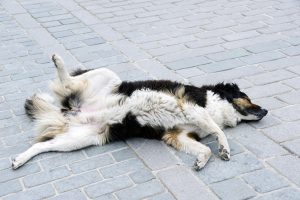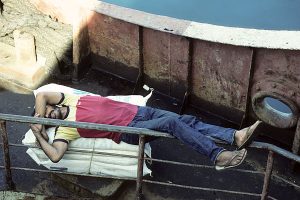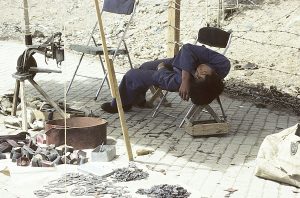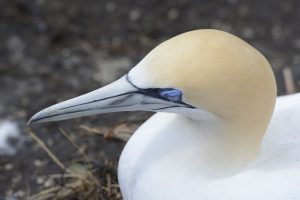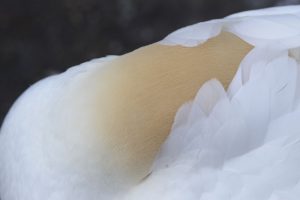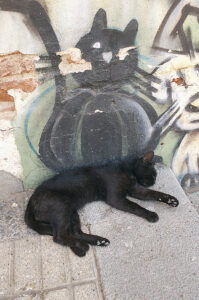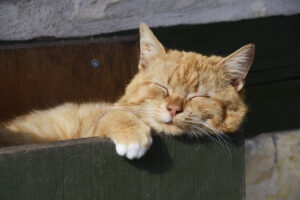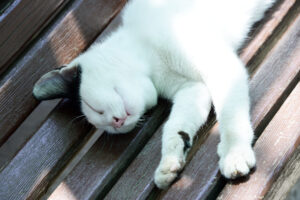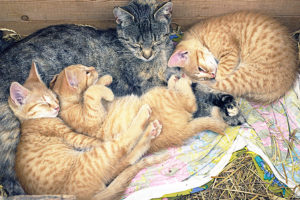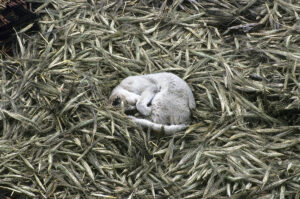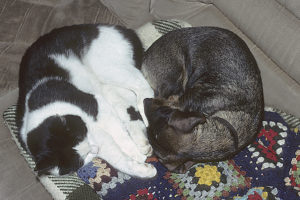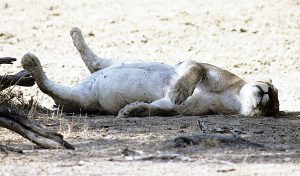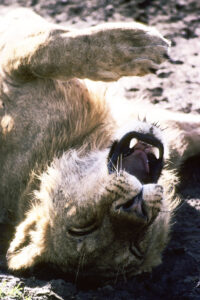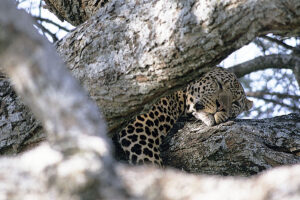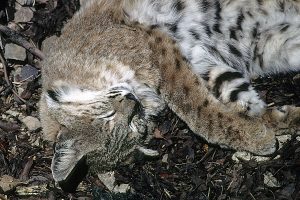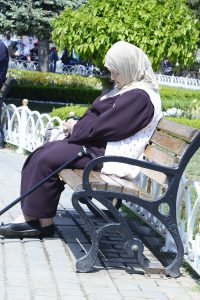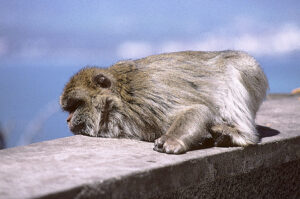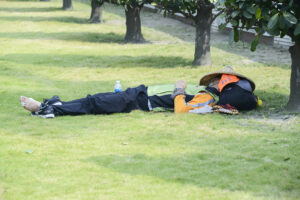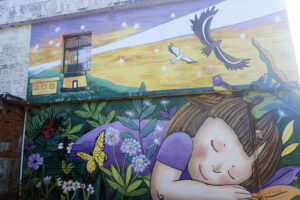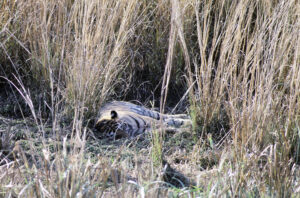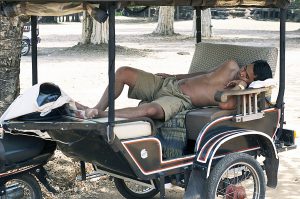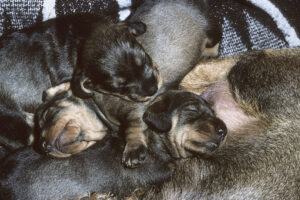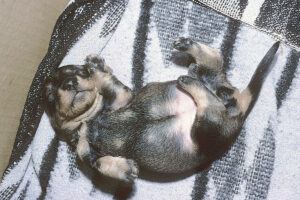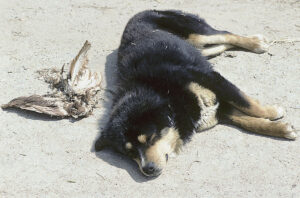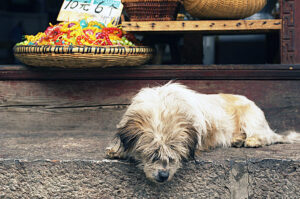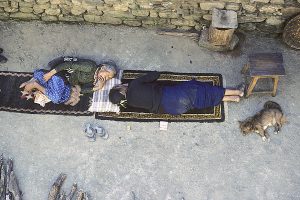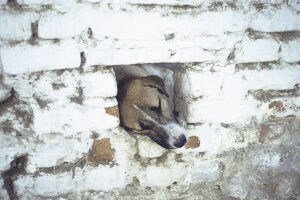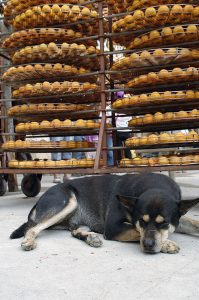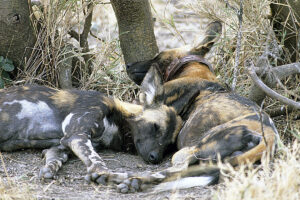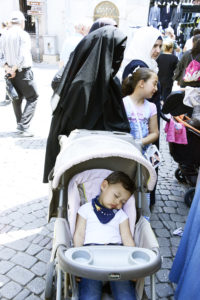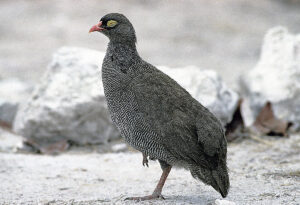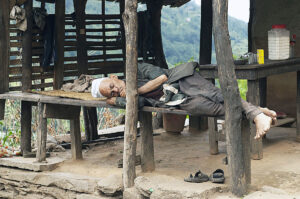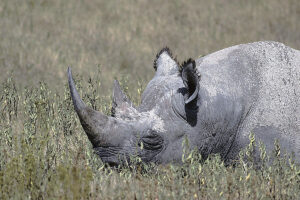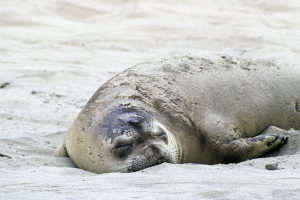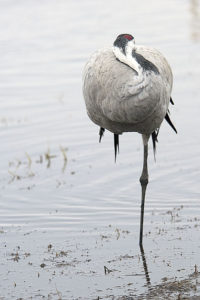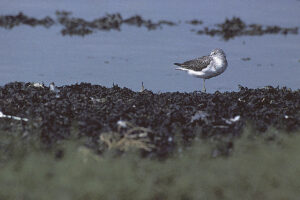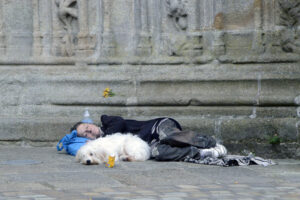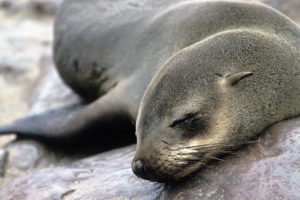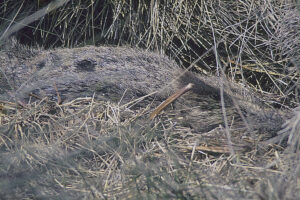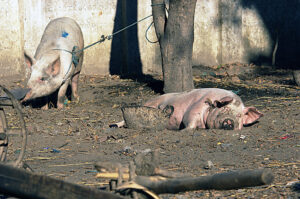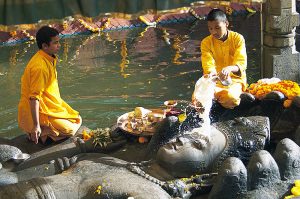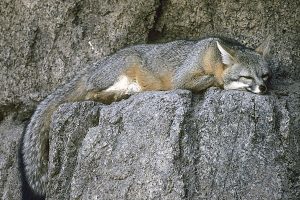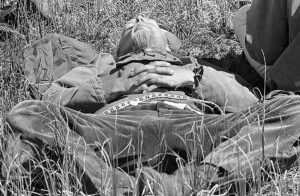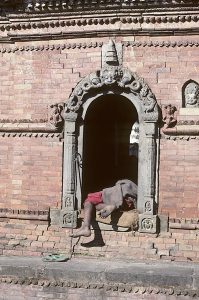Sleep
Six examples of the art of relaxation.
Istanbul, Turkey. (Photo copyright © by Kaj Halberg)
On board a ferry between Luzon and Mindoro, Philippines. (Photo copyright © by Kaj Halberg)
Cycle-rickshaw driver, Delhi, India. (Photo copyright © by Kaj Halberg)
Hanoi, Vietnam. (Photo copyright © by Kaj Halberg)
Children, sleeping on a sidewalk, Kathmandu, Nepal. The one in front has assumed an unusual posture, whereas the other is covered to protect it from flies. (Photo copyright © by Kaj Halberg)
During a lull in his business, this shoemaker in Shigatse, Tibet, is napping in an alternative position. On the pavement, he has spread out shoe heels, metal fittings, and other items. (Photo copyright © by Kaj Halberg)
What is more gentle than a wind in summer?
What is more soothing than the pretty hummer
That stays one moment in an open flower,
And buzzes cheerily from bower to bower?
What is more tranquil than a musk-rose blowing
In a green island, far from all men’s knowing?
More healthful than the leafiness of dales?
More secret than a nest of nightingales?
More serene than Cordelia’s countenance?
More full of visions than a high romance?
What, but thee Sleep? Soft closer of our eyes!
Low murmurer of tender lullabies!
Light hoverer around our happy pillows!
Wreather of poppy buds, and weeping willows!
Silent entangler of a beauty’s tresses!
Most happy listener! when the morning blesses
Thee for enlivening all the cheerful eyes
That glance so brightly at the new sun-rise.
First verse of Sleep and Poetry (1817), by English poet John Keats (1795-1821), who became famous, although his works had been in publication for only 4 years before he died from tuberculosis, aged 25.
Taiwanese mother and daughter. (Photo copyright © by Kaj Halberg)
The Australian gannet (Morus serrator) was first known to scientists during Captain James Cook’s first great voyage on board the Endeavor (1768-1771), when English naturalist Sir Joseph Banks (1743-1820) shot three specimens on 24th December 1769, off Three Kings Islands, New Zealand.
In his journal, Banks noted: “Calm most of the Day: myself in a boat shooting, in which I had good success, killing cheifly several Gannets or Solan Geese, so like European ones they are hardly distinguishable from them. As it was the humour of the ship to keep Christmas in the old fashiond way, it was resolved of them to make a Goose pye for tomorrows dinner.”
On Christmas Day, Banks recorded that “our goose pye was eaten with great approbation.” – Therefore, it is hardly surprising that none of these specimens found their way to England, considering that a goose is best when fried with the skin on!
Swedish naturalist Daniel Carlsson Solander (1733-1782), who was assistant to Banks, described the bird, naming it Pelecanus chrysocephalus, but later changing it to Pelecanus sectator. Scotsman Sydney Parkinson (c. 1745-1771), who was the official artist on board the Endeavor, illustrated the bird as P. sectator, which was misread as P. serrator by later authorities.
In 1841, English ornithologist John Gould (1804-1881) described specimens of this bird from Tasmania as Sula australis. This name, however, had already been used for the red-footed booby. In 1843, English zoologist George Robert Gray (1808-1872) wrote of the species, using Gould’s name, but later changed it to Sula serrator, based on Parkinson’s drawing. (Source: Medway, D.G. 1993. The type specimen of the Australasian Gannet. Notornis 40: 65-70)
The Australian gannet has since been moved to the genus Morus, together with the northern gannet (M. bassanus) and the African Cape gannet (M. capensis). They are all very similar, but are generally considered to be separate species, although some authorities regard the Australian gannet and the Cape gannet as subspecies of M. bassanus.
Incidentally, the name Morus is derived from the Greek moros (‘foolish’), due to the lack of fear shown by these birds at the breeding ground, making it easy to kill them.
Dozing Australian gannet (top), and a sleeping bird, which has hidden its head among the back feathers, both photographed at Muriwai Beach, New Zealand. (Photos copyright © by Kaj Halberg)
During the Catholic Festival of the Dead, Guatemalan men drink huge amounts of a local alcohol, quetzalteca, made from sugar cane. This festival is described on the page Travel episodes – Guatemala 1998: Land of the Mayans.
Despite heavy rain, this dead-drunk man has fallen asleep in a street in the town of Todos Santos. (Photo copyright © by Kaj Halberg)
Cats are able to sleep almost anywhere. The following pictures show various species of sleeping cats, photographed around the world.
The origin of the domestic cat is described on the page Animals: Animals as servants of Man.
Black cat, sleeping beneath a wall painting, depicting – a black cat, Valparaiso, Chile. (Photo copyright © by Kaj Halberg)
This tomcat is sleeping in a wooden box, intended for kittens. He probably slept in it, when he was young, so he feels at home in it. – Funen, Denmark. (Photo copyright © by Kaj Halberg)
Izmir, Turkey. (Photo copyright © by Kaj Halberg)
This cat and her kittens are sleeping in a wooden box, Funen, Denmark. (Photo copyright © by Kaj Halberg)
Cats have a fantastic sense of balance. This cat is sleeping on a fence, Jutland, Denmark. (Photo copyright © by Kaj Halberg)
Cat, sleeping in drying wheat, Siduwa, Arun Valley, eastern Nepal. (Photo copyright © by Kaj Halberg)
Usually, cats and dogs are sworn enemies, but if they grow up together, like this cat and wire-haired dachshund, they can be the best of friends. (Photo copyright © by Kaj Halberg)
The lion (Panthera leo) is described on the page Animals – Mammals: Lion – king of the savanna, and an unusual nightly adventure with lions is related on the page Travel episodes – Tanzania 1990: Lions in the camp.
Lioness, sleeping in the shade of a tree, Kalahari Gemsbok National Park, South Africa. (Photo copyright © by Kaj Halberg)
Young male lion, yawning, Ngorongoro Crater, Tanzania. (Photo copyright © by Kaj Halberg)
The leopard (Panthera pardus) has a very wide distribution, from Ussuriland in south-eastern Russia southwards through parts of China and Southeast Asia to Indonesia, and thence westwards through the Indian Subcontinent to the Middle East, and most of sub-Saharan Africa. It has adapted to a huge variety of habitats, from tropical jungles to semi-desert and mountains, and even farmland near villages.
The leopard is described in depth, including the account of a terrible man-eater in northern India, on the page Animals – Mammals: The spotted killer.
Digesting its meal, this leopard is sleeping in a tree, Serengeti National Park, Tanzania. (Photo copyright © by Kaj Halberg)
Twelve subspecies of the bobcat (Lynx rufus) are recognized, widely distributed across North America, from southern Canada southwards to central Mexico. This solitary cat inhabits various habitats, such as forests, grasslands, swamps, and semi-desert, as well as some suburban areas. Despite this adaptability, it is declining over much of its area, due to competition with the successful coyote (Canis latrans) and feral domestic dogs.
Sleeping female bobcat, Tucson Desert Zoo, Arizona. (Photo copyright © by Kaj Halberg)
During a visit to a park in Istanbul, Turkey, this elderly woman was overcome by fatigue. (Photo copyright © by Kaj Halberg)
Avoiding the harshest areas of the Arctic, the striking northern pintail (Anas acuta) breeds across the northern hemisphere, from Iceland, Norway, and Denmark eastwards to the Pacific, and also from Alaska and Canada southwards to central United States. It is a scarce breeding bird in central and eastern Europe, and in Turkey.
The winter months are spent in the southern half of North America, in Central America and the Caribbean, in the major part of Europe and the Middle East, in northern and eastern Africa, and in the Indian Subcontinent, Indochina, southern China, Taiwan, and the northern Philippines.
The specific name is Latin, meaning ‘sharp-pointed’, like the common name alluding to the long, pointed tail.
As a breeding bird, the northern shoveler (Spatula clypeata) is widely distributed across the northern hemisphere, likewise avoiding the harshest areas of the Arctic. It is found from Iceland, the British Isles, Spain, and Morocco eastwards across the taiga belt to the Pacific, and also in Alaska and western North America, southwards almost to the Mexican border.
The winter months are spent in the southern half of North America, in Central America and the Caribbean, in the major part of Europe and the Middle East, in northern and eastern Africa, and in the Indian Subcontinent, Southeast Asia, southern China, Korea, Japan, Taiwan, and the northern Philippines.
The specific name is Latin, meaning ‘shield-bearing’, alluding to the broad and flat bill.
Sleeping northern pintails and northern shovelers, Aogu Wetlands. (Photo copyright © by Kaj Halberg)
Of the 23 species of macaque, the long-tailed macaque (Macaca fascicularis) is the most widespread, found from Bangladesh, Myanmar, Laos, and Vietnam, southwards to the Malaysian and Indonesian Archipelago, and thence eastwards to the Philippines.
This species and many other monkeys are described on the page Animals – Mammals: Monkeys and apes.
Young long-tailed macaque, sleeping with its mother on a wall near the Wenara Wana Temple (popularly called ‘Monkey Forest’), Ubud, Bali, Indonesia. (Photo copyright © by Kaj Halberg)
The Gibraltar Rock, southern Spain, is home to a population of about 300 Barbary macaques (Macaca sylvanus), divided into five troops. This species, which is native to the Atlas Mountains of Morocco, was possibly introduced to the rock by the Moors.
Barbary macaque, sleeping on a wall atop the Gibraltar Rock. (Photo copyright © by Kaj Halberg)
Over the years, the dominating religion in Taiwan has become a unique blend of Buddhism and Daoism, with a bewildering array of Daoist gods, which are worshipped on equal terms with the Buddha. Daoism is described in depth on the page Religion: Daoism in Taiwan.
Participating in Daoist festivals, pilgrims often walk for days from one temple to the next. This is very demanding, so during the festivals you often observe sleeping people, in the temples, which have rooms to house tired pilgrims, or simply in the streets or elsewhere.
During a festival, dedicated to the Daoist Mother Goddess Mazu, pilgrims are resting in the Fushing Temple, Xiluo. (Photo copyright © by Kaj Halberg)
This tired pilgrim has fallen asleep between two pillars in the Fushing Temple. (Photo copyright © by Kaj Halberg)
This tired pilgrim is sleeping on a lawn. (Photo copyright © by Kaj Halberg)
In front of the Fushing Temple in Xiluo, this handicapped man is selling fake money, to be burned as offerings during a festival in honour of the Mother Goddess Mazu. At the moment, his business is not doing so well, so he has fallen asleep. (Photo copyright © by Kaj Halberg)
During a festival for the Daoist Tiger God, taking place in the town of Shingang, these participants were overcome by fatigue. (Photo copyright © by Kaj Halberg)
During Daoist festivals, so-called lion dances are often performed in front of temples. As a rule, it is performed by two men, hidden under a gaily coloured cloth, which acts as the body of the lion, whereas a lion mask is held by the man in front.
Participating in a procession during the Daoist festival Tzuoh Jiaw, taking place in the village of Dalinpo, near Kaohshiung, these lion dancers have fallen asleep among their outfit. During this festival, local gods are worshiped to prevent bad events. (Photo copyright © by Kaj Halberg)
Busture i Nepal er ofte langvarige og trættende. Disse piger er faldet i søvn undervejs. (Foto copyright © by Kaj Halberg)
Wall painting, depicting a sleeping child, Laomei, northern Taiwan. (Photo copyright © by Kaj Halberg)
In the midday heat, these taxi drivers are napping on a wall, Lassithi, Crete, Greece. (Photo copyright © by Kaj Halberg)
This elderly man in Hanoi, Vietnam, was overcome by fatigue. (Photo copyright © by Kaj Halberg)
His head-strap still wrapped around his forehead, this tired porter has fallen asleep on the foundation of a small Hindu shrine, Kathmandu, Nepal. (Photo copyright © by Kaj Halberg)
The red-billed duck (Anas erythrorhyncha) is widely distributed in sub-Saharan Africa, from Ethiopia and Somalia southwards to South Africa, and also on Madagascar. However, it is missing in the rainforest areas of West Africa.
Sleeping red-billed duck, Ngorongoro Crater, Tanzania. (Photo copyright © by Kaj Halberg)
The indigenous peoples of Borneo are generally known as Dayaks, comprising tribes like Iban, Punan, Kayan, Kelabit, and Penan, among others.
My adventures with the Punan people are described on the page Travel episodes – Borneo 1975: Canoe trip with Punan tribals.
While breast-feeding her child, this Dayak woman has fallen asleep on the deck of a passenger boat, travelling up the Rajang River, Sarawak. (Photo copyright © by Kaj Halberg)
The sad fate of the tiger (Panthera tigris) is described on the page Animals – Mammals: Mammals in the Indian Subcontinent.
Sleeping tiger, Ranthambhor National Park, Rajasthan, India. (Photo copyright © by Kaj Halberg)
While waiting for their customers to return from sightseeing in the Angkor area, Cambodia, these drivers of tuk-tuks, or motorcycle taxis, are napping. (Photos copyright © by Kaj Halberg)
On my travels around the world, I have often encountered sleeping dogs. The complicated ancestry of the domestic dog is described on the page Animals: Animals as servants of Man.
This baby in the Ghunsa Valley, eastern Nepal, is very snug, lying on his mother’s front porch. The dogs may seem asleep, but they make sure that nothing will harm the child. Note that one of the dogs has a half-open eye, watching whether my doings are harmless. (Photo copyright © by Kaj Halberg)
A little girl and a wire-haired dachshund, sleeping together on a sofa, Jutland, Denmark. (Photo copyright © by Kaj Halberg)
Sleeping pups of wire-haired dachshund, 3 weeks old, Jutland, Denmark. (Photos copyright © by Kaj Halberg)
These dogs have found a peaceful place to sleep near the Hadimba Temple, Manali, Himachal Pradesh, India. – This temple and other aspects of Hinduism are described on the page Religion: Hinduism. (Photo copyright © by Kaj Halberg)
This dog in the Kathmandu Valley, Nepal, probably ate the bird and fell asleep beside it. (Photo copyright © by Kaj Halberg)
Dog, sleeping atop a staircase, which seemingly leads into empty space, Nyaung Shwe, Lake Inle, Myanmar. (Photo copyright © by Kaj Halberg)
This dog, sleeping on a sidewalk in Bangkok, Thailand, is indeed very warmly dressed, considering that the temperature was around 30 degrees Centigrade! The snout is pointing to the left. (Photo copyright © by Kaj Halberg)
During the Hindu festival Holi, or ‘Festival of Colours’, this dog in Jaisalmer, Rajasthan, India, has been sprayed with coloured water. My own ‘colourful’ adventures during Holi are described on the page Travel episodes – India 1991: Attending Hindu festivals in Rajasthan. (Photo copyright © by Kaj Halberg)
Dog, sleeping outside a shop, Lijiang, Yunnan Province, China. (Photo copyright © by Kaj Halberg)
Tibetan women and their dog, napping in the courtyard in the warm midday sun, Pokhara, Nepal. (Photo copyright © by Kaj Halberg)
One of the first dogs to be domesticated by humans was the Indian pariah dog, also called desi dog, which is native to the Indian subcontinent. This dog is medium-sized, with short coat, pointed muzzle, and often curved tail. Most pariah dogs are various shades of brown, ranging from dark-brown to reddish-brown, or sometimes black, and some are pied.
This breed was named by the British Raj, after the Pariah tribe near Chennai, derived from the Hindi word pahi (‘outsider’), which was Anglicized to pariah or pye. The alternative name Desi dog is derived from Urdu desi (‘native’).
This pariah dog is sleeping, its head sticking out through a hole in a wall, Udaipur, Rajasthan. (Photo copyright © by Kaj Halberg)
Pariah bitch, sleeping with her pups in a heap of garbage, Varanasi, India. (Photo copyright © by Kaj Halberg)
The common stray dogs of Taiwan, called Taiwan dogs, or sometimes Takasago dogs, are a result of indigenous Formosan hunting dogs, interbreeding with imported dog types. Taiwan dogs are usually black or brown, or a mixture of the two.
Taiwan dog, sleeping in front of drying persimmons (Diospyros kaki), Xinpu. (Photo copyright © by Kaj Halberg)
The fascinating African hunting dog (Lycaon pictus) is described on the page Animals – Mammals: Hunting dogs – nomads of the savanna.
Sleeping African hunting dogs, Serengeti National Park, Tanzania. Note that one of the dogs is wearing a radio collar for tracking. (Photo copyright © by Kaj Halberg)
During the midday heat, this man is sleeping in a niche inside the Hakim Mosque, Old Cairo, Egypt. (Photo copyright © by Kaj Halberg)
Every year in November, thousands of Hindu pilgrims undertake a pilgrimage to the Gandak River at Sonpur, Bihar, northern India. In connection with this festival, a huge market, or mela, is held. Two other pictures from this mela are shown on the page Shadows.
Despite the tremendous noise from numerous loudspeakers, this woman and her daughter, who are partaking in the Sonpur mela, are sound asleep among their belongings. (Photo copyright © by Kaj Halberg)
Sleeping child, Izmir, Turkey. (Photo copyright © by Kaj Halberg)
The red-billed spurfowl (Pternistis adspersus) is quite common in southern Africa, from Angola and Zambia southwards. Standing on one leg, this one in Etosha National Park, Namibia, is dozing. The systematics of spurfowl and francolins is explained on the page Animals – Birds: Birds in Africa. (Photo copyright © by Kaj Halberg)
During a lull in his business in the midday heat, this roadside vendor in Kendja, Solu, eastern Nepal, is sleeping peacefully on a bench. (Photo copyright © by Kaj Halberg)
Young man, sleeping beside his pushcart, Manila, Luzon, Philippines. (Photo copyright © by Kaj Halberg)
During a forest hike, this little girl has fallen asleep on her father’s back, Jutland, Denmark. (Photo copyright © by Kaj Halberg)
Young man, taking a nap on a bench in a city park, Hanoi, Vietnam. (Photo copyright © by Kaj Halberg)
A tiny population of the globally threatened black rhinoceros (Diceros bicornis) is lingering in the Ngorongoro Crater, northern Tanzania. Here, they are closely guarded by rangers against poachers, who sell rhino horns to middle men, who in turn export them to China, where they are used as an ingredient in traditional medicine. This illegal trade is described on the page Folly of Man.
Napping black rhino, Ngorongoro Crater, Tanzania. (Photo copyright © by Kaj Halberg)
In Indian railways stations, a common sight is passengers who sleep on the platform while waiting for their train. Two examples are shown below.
Delhi Railway Station. (Photo copyright © by Kaj Halberg)
Varanasi Railway Station, Uttar Pradesh. (Photo copyright © by Kaj Halberg)
Man, taking a nap, Hanoi, Vietnam. (Photo copyright © by Kaj Halberg)
Elephant seals derive their name from their great size, and also from the male’s large, inflatable proboscis, with which he makes loud roaring noises, especially during the mating season. While moulting, elephant seals spend a lot of time sleeping on their moulting site.
Formerly, elephant seals were hunted extensively for their blubber, from which oil was made. By 1869, the northern elephant seal (Mirounga angustirostris) had been almost extirpated, and around 1890 only one group, comprising about 100 animals, was known to exist. However, the species managed to survive, and since the early 20th century it has been protected by law in Mexico and the United States. Subsequently, it has now recovered, counting more than 200,000 individuals. Today, it occurs in scattered colonies along the Pacific Coast, from Baja California at least as far north as British Columbia.
When moulting, elephant seals spend a lot of time sleeping, like this female northern elephant seal, lying on the beach in Año Nuevo State Park, California. (Photo copyright © by Kaj Halberg)
Wearing a hat against the winter cold (but no socks), this tired rickshaw-driver is napping on his bicycle, Haridwar, Uttarakhand, India. (Photo copyright © by Kaj Halberg)
The Eurasian crane (Grus grus) is the most widely distributed crane species in the world, found from England, eastwards across the entire Siberian taiga to northern Mongolia and China, with small isolated populations in southern Europe, Turkey, the Caucasus, and Tibet. Subspecies archibaldi from Turkey and the Caucasus was described scientifically as late as 2008. Formerly, eastern Asian populations were regarded as a separate subspecies, lilfordi, but today most authorities consider these birds as belonging to the nominate race.
With a total population of nearly 700,000, the Eurasian crane is one of the most numerous crane species, only surpassed by the sandhill crane (Antigone canadensis). In western Europe, breeding numbers have increased dramatically in several countries, including Sweden with 15,000 to 20,000 pairs, Germany with about 8.000 pairs, and Denmark with about 500 pairs. In 1998, the total number in Europe was estimated at 45,000 pairs, but this number has since increased significantly.
The sandhill crane is described on the page Animals – Birds: Sandhill cranes – a threat to breeding birds. Pictures, depicting various other crane species, are shown in the gallery at Animals: Cranes.
This Eurasian crane is sleeping, standing on one leg in Lake Hornborgasjön, Sweden. This lake is visited by up to 10,000 cranes in March-April, resting here on their way to the breeding grounds. (Photo copyright © by Kaj Halberg)
Tired little girl, sleeping in a chair, Kilcolgan, Ireland. (Photo copyright © by Kaj Halberg)
Formerly, the giant panda (Ailuropoda melanoleuca) was considered closely related to the red panda (Ailurus fulgens), lumped in the family Ailuridae. However, DNA studies have revealed that, in fact, the giant panda belongs to the bear family (Ursidae), and is not closely related to the red panda, which is now the sole member of Ailuridae. Despite being a carnivore, the diet of the giant panda is more than 99% bamboo stems and leaves, supplemented by other grasses, wild tubers, birds, rodents, and carrion.
Unlike other bears, giant pandas do not have round pupils, but vertical slits, like cats. This gave rise to the generic name Ailuropoda, from the Greek ailouros (‘cat’) and pous (‘foot’), and also to the Chinese name 大熊猫 (‘big bear-cat’).
Once widespread throughout southern China, as far north as Beijing, and southwards into Southeast Asia, the giant panda is now confined to the Chinese provinces Sichuan, Shaanxi, and Gansu. It is highly endangered, numbering only about 2,000 individuals in the wild. An increase in available habitat provides support for the contention that its numbers are increasing. Forest protection and reforestation measures have supported an 11.8% increase in panda-occupied habitat, and a 6.3% increase in unoccupied, but suitable habitat. Although the panda population is currently increasing, climate change is predicted to eliminate more than 35% of its bamboo habitat in the next 80 years, and thus the population is projected to decline. (Source: iucnredlist.org/details/712/0)
Sleeping giant panda, Chengdu Zoo, Sichuan Province, China. (Photo copyright © by Kaj Halberg)
In the city of Bhaktapur, Kathmandu Valley, Nepal, the Hindu festival Bisket Jatra is celebrated with vigor by the Newar population. This festival is described in depth on the page Religion: Hinduism.
During Bisket Jatra, this Newar woman has wrapped a cloth around her sleeping child on her back. She has also applied charcoal around the eyes of the child to keep flies away. (Photo copyright © by Kaj Halberg)
The red-necked grebe (Podiceps grisegena) was named for its red neck in the breeding plumage. It has a very large distribution, found from Denmark, Sweden, Germany, and the Balkans eastwards to south-western Siberia and Kazakhstan, from eastern Siberia southwards to northern China and Sakhalin, and in north-western North America, eastwards to the Great Lakes.
Red-necked grebe, sleeping while incubating, Copenhagen, Denmark. (Photo copyright © by Kaj Halberg)
Boy, sleeping on a broken staircase, leading up to an ancient Buddhist temple, Anuradhapura, Sri Lanka. It doesn’t look too comfortable! (Photo copyright © by Kaj Halberg)
The greenshank (Tringa nebularia) is a common breeding bird in the northern subarctic zone, from northern Scotland and Scandinavia across the Siberian taiga to Chukotka and the Kamchatka Peninsula. It is migratory, spending the winter in Africa, southern Asia and Australia. It forms a superspecies together with the greater yellowlegs (T. melanoleuca) of North America and the spotted redshank (T. erythropus), which breeds in northern Scandinavia and Siberia.
Napping greenshank, Horsens Fjord, Denmark. (Photo copyright © by Kaj Halberg)
Homeless people are forced to sleep, wherever and whenever they have the possibility to do so.
Pedestrians hurry past a homeless woman, sleeping on the sidewalk, Jaipur, Rajasthan, India. (Photo copyright © by Kaj Halberg)
Homeless men, sleeping on sidewalks, Delhi, India. (Photos copyright © by Kaj Halberg)
While begging, this one-legged man fell asleep, Kathmandu, Nepal. (Photo copyright © by Kaj Halberg)
Mother and child, sleeping on a sidewalk, Ubud, Bali, Indonesia. (Photo copyright © by Kaj Halberg)
This beggar in Panadura, Sri Lanka, has found shelter at a bus stop, where he is now sleeping, surrounded by his few belongings. (Photo copyright © by Kaj Halberg)
A boy and his dog, sleeping on a sidewalk, Kathmandu, Nepal. (Photo copyright © by Kaj Halberg)
Homeless woman, sleeping outside the cathedral, Quimper, Brittany. (Photo copyright © by Kaj Halberg)
Beggar, sleeping on a sidewalk, Mamallapuram, Tamil Nadu, India. The script on the wall is Tamil. (Photo copyright © by Kaj Halberg)
Homeless woman, sleeping on a sidewalk with her two dogs, Bangkok, Thailand. (Photo copyright © by Kaj Halberg)
Sleeping children, huddled up on a sidewalk, Delhi, India. (Photo copyright © by Kaj Halberg)
While selling fruits at a market in Antigua, Guatemala, this woman has wrapped a cloth around her sleeping child on her back. – Our adventures in Guatemala are related on the page Travel episodes – Guatemala 1998: Land of the Mayans. (Photo copyright © by Kaj Halberg)
There are two widely separated populations of the brown, or Afro-Australian, fur seal (Arctocephalus pusillus), the South African, or Cape, fur seal, subspecies pusillus, and the Australian fur seal, subspecies doriferus. The Cape fur seal ranges along the southern coasts of Africa, from Ilha dos Tigres in southern Angola, along the Namibian coast to Algoa Bay in South Africa, whereas the Australian subspecies lives in south-eastern Australian waters, along the coasts of Tasmania, New South Wales, Victoria, and South Australia, with the largest concentration in the Bass Strait. Their preferred breeding habitats are rocky islands, and pebble or boulder beaches. The population of the Cape fur seal is approximately 2 million, whereas that of the Australian fur seal is around 120,000. (Source: iucnredlist.org/details/2060/0)
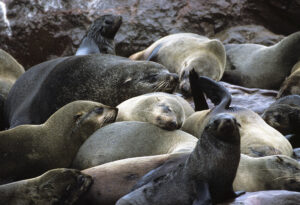
Surrounded by his harem in a breeding colony at Cape Cross, Namibia, this bull Cape fur seal enjoys a break in his wrestling with other males, which will try to mate with his females. (Photo copyright © by Kaj Halberg)
Sleeping female, Cape Cross. (Photo copyright © by Kaj Halberg)
These women have got a lift on the back of a truck, Hetauda, southern Nepal. One of them has fallen asleep on sacks of grain. (Photo copyright © by Kaj Halberg)
While trying to sell her goods, this street vendor in Kota Bharu, Malaysia, has fallen asleep. (Photo copyright © by Kaj Halberg)
In the south-eastern corner of the huge Caspian Sea, northern Iran, a 70-kilometre-long sand spit, Mian Kaleh, stretches towards the east, hereby creating a large inlet, named Gorgan Bay. In April 1973, my companion Arne Koch Christoffersen and I stayed in this area for two weeks, studying the northbound bird migration. Numerous birds follow the shoreline, concentrating in numbers at this sand spit. Among other migrating species, we observed Eurasian crane (Grus grus), pallid harrier (Circus macrourus), imperial eagle (Aquila heliaca), steppe eagle (A. nipalensis), peregrine (Falco peregrinus), and Egyptian vulture (Neophron percnopterus).
Our adventures in this area are related on the page Travel episodes – Iran 1973: Car breakdown at the Caspian Sea.
One day during our stay on Mian Kaleh, I heard a snoring sound from a dense patch of grass. As it turned out, this sound stemmed from a wild boar (Sus scrofa), sleeping in its nest. When I approached too close, it suddenly jumped up and took off at a tremendous speed, while my heart jumped into my mouth. (Photo copyright © by Kaj Halberg)
Many places in Asia, a pig sty is a very basic affair – or simply lacking. These pigs in central Myanmar have simply been tied to a tree at the road side. The domestic pig is described on the page Animals: Animals as servants of Man. (Photo copyright © by Kaj Halberg)
Remarkable English on a sign along a highway, Yunnan Province, China. (Photo copyright © by Kaj Halberg)
In Budhanilkantha, Kathmandu Valley, Nepal, a 6-metre-long sculpture, called The Reclining Vishnu, has been carved from one huge rock. He is depicted reclining in The Cosmic Ocean, resting on a somewhat unusual bed – the eleven-headed cobra Anantha Naga.
Vishnu and other Hindu gods are described on the page Religion: Hinduism.
During the festival Haribondhi Ekadasi, the face of The Reclining Vishnu is being cleaned ritually with milk. (Photo copyright © by Kaj Halberg)
Sleeping Sinhalese boy, Sri Lanka. (Photo copyright © by Kaj Halberg)
In 1988, together with other Danish bird watchers, I participated in a research trip to investigate the occurrence of waders along the Tanzanian coast. Our adventures on this trip are related on the page Travel episodes – Tanzania 1988: Experiencing African bureaucracy.
Danish biologist Ib Krag Petersen assumes an alternative resting position on board our research boat Gaia Quest. (Photo copyright © by Kaj Halberg)
While trying to sell peas, this street vendor has fallen asleep, Aswan, Egypt. (Photo copyright © by Kaj Halberg)
In the warm summer sun, this elderly man has fallen asleep in his chair in the street, Chengdu, Sichuan Province, China. (Photo copyright © by Kaj Halberg)
Truck driver, sleeping in his cabin, Medan, Sumatra, Indonesia. (Photo copyright © by Kaj Halberg)
Man, sleeping among sacks of grain, Kathmandu, Nepal. (Photo copyright © by Kaj Halberg)
Sleeping hippo (Hippopotamus amphibious), resting its head on a companion’s back, Ngorongoro Crater, Tanzania. This enormous animal is described on the page Animals – Mammals: Hippo – the river horse that lives on both sides. (Photo copyright © by Kaj Halberg)
Workers, napping on stacked timber during their midday break, Shigatse, Tibet. (Photo copyright © by Kaj Halberg)
Well dressed for cold weather, this little boy is sleeping in a pram, Þingvellir, Iceland. (Photo copyright © by Kaj Halberg)
The grey fox (Urocyon cinereoargenteus) is widely distributed, from southern Canada south through Central America to Columbia and Venezuela. This species and other members of the dog family are described on the page Animals – Mammals: Dog family.
Sleeping grey fox, Tucson Desert Zoo, Arizona. (Photo copyright © by Kaj Halberg)
During a hike at Fokstumyr, Dovrefjell, Norway, Danish ornithologist Knud Pedersen is sleeping in a relaxed posture. (Photo copyright © by Kaj Halberg)
The small common teal (Anas crecca) has an enormous distribution, breeding in most Northern Temperate and Arctic areas, with the exception of Greenland and northern Canada. It winters further south, in subtropical and tropical areas of Europe, Africa, Asia, and North America. The American subspecies, called green-winged teal, is often regarded as a separate species, Anas carolinensis.
Standing on a partially submerged tree trunk in a pond, this common teal is napping, Horsens Fjord, Denmark. (Photo copyright © by Kaj Halberg)
Woman, transporting a bed, Jodhpur, Rajasthan, India. (Photo copyright © by Kaj Halberg)
This man is napping in the doorway to a Shiva temple, Pashupatinath, Kathmandu, Nepal. (Photo copyright © by Kaj Halberg)
(Uploaded January 2018)
(Latest update October 2024)
